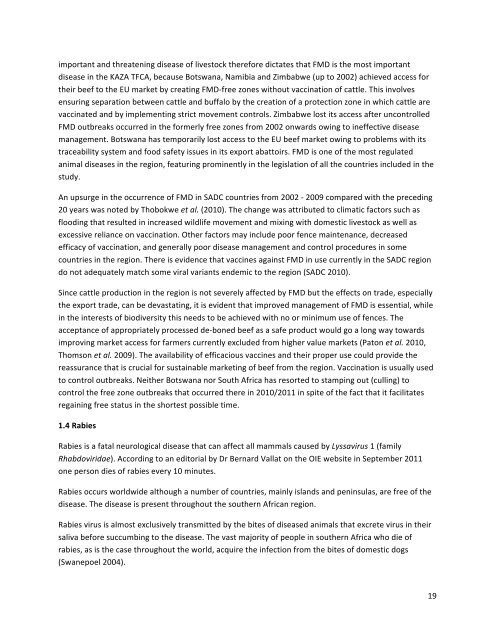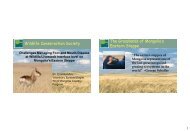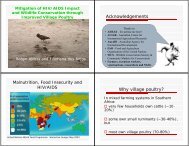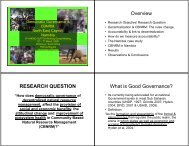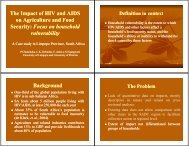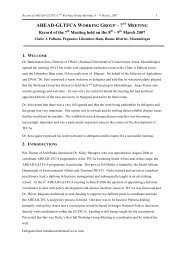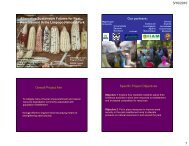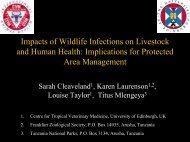Download - Animal & Human Health for the Environment and ...
Download - Animal & Human Health for the Environment and ...
Download - Animal & Human Health for the Environment and ...
You also want an ePaper? Increase the reach of your titles
YUMPU automatically turns print PDFs into web optimized ePapers that Google loves.
important <strong>and</strong> threatening disease of livestock <strong>the</strong>re<strong>for</strong>e dictates that FMD is <strong>the</strong> most important disease in <strong>the</strong> KAZA TFCA, because Botswana, Namibia <strong>and</strong> Zimbabwe (up to 2002) achieved access <strong>for</strong> <strong>the</strong>ir beef to <strong>the</strong> EU market by creating FMD-‐free zones without vaccination of cattle. This involves ensuring separation between cattle <strong>and</strong> buffalo by <strong>the</strong> creation of a protection zone in which cattle are vaccinated <strong>and</strong> by implementing strict movement controls. Zimbabwe lost its access after uncontrolled FMD outbreaks occurred in <strong>the</strong> <strong>for</strong>merly free zones from 2002 onwards owing to ineffective disease management. Botswana has temporarily lost access to <strong>the</strong> EU beef market owing to problems with its traceability system <strong>and</strong> food safety issues in its export abattoirs. FMD is one of <strong>the</strong> most regulated animal diseases in <strong>the</strong> region, featuring prominently in <strong>the</strong> legislation of all <strong>the</strong> countries included in <strong>the</strong> study. An upsurge in <strong>the</strong> occurrence of FMD in SADC countries from 2002 -‐ 2009 compared with <strong>the</strong> preceding 20 years was noted by Thobokwe et al. (2010). The change was attributed to climatic factors such as flooding that resulted in increased wildlife movement <strong>and</strong> mixing with domestic livestock as well as excessive reliance on vaccination. O<strong>the</strong>r factors may include poor fence maintenance, decreased efficacy of vaccination, <strong>and</strong> generally poor disease management <strong>and</strong> control procedures in some countries in <strong>the</strong> region. There is evidence that vaccines against FMD in use currently in <strong>the</strong> SADC region do not adequately match some viral variants endemic to <strong>the</strong> region (SADC 2010). Since cattle production in <strong>the</strong> region is not severely affected by FMD but <strong>the</strong> effects on trade, especially <strong>the</strong> export trade, can be devastating, it is evident that improved management of FMD is essential, while in <strong>the</strong> interests of biodiversity this needs to be achieved with no or minimum use of fences. The acceptance of appropriately processed de-‐boned beef as a safe product would go a long way towards improving market access <strong>for</strong> farmers currently excluded from higher value markets (Paton et al. 2010, Thomson et al. 2009). The availability of efficacious vaccines <strong>and</strong> <strong>the</strong>ir proper use could provide <strong>the</strong> reassurance that is crucial <strong>for</strong> sustainable marketing of beef from <strong>the</strong> region. Vaccination is usually used to control outbreaks. Nei<strong>the</strong>r Botswana nor South Africa has resorted to stamping out (culling) to control <strong>the</strong> free zone outbreaks that occurred <strong>the</strong>re in 2010/2011 in spite of <strong>the</strong> fact that it facilitates regaining free status in <strong>the</strong> shortest possible time. 1.4 Rabies Rabies is a fatal neurological disease that can affect all mammals caused by Lyssavirus 1 (family Rhabdoviridae). According to an editorial by Dr Bernard Vallat on <strong>the</strong> OIE website in September 2011 one person dies of rabies every 10 minutes. Rabies occurs worldwide although a number of countries, mainly isl<strong>and</strong>s <strong>and</strong> peninsulas, are free of <strong>the</strong> disease. The disease is present throughout <strong>the</strong> sou<strong>the</strong>rn African region. Rabies virus is almost exclusively transmitted by <strong>the</strong> bites of diseased animals that excrete virus in <strong>the</strong>ir saliva be<strong>for</strong>e succumbing to <strong>the</strong> disease. The vast majority of people in sou<strong>the</strong>rn Africa who die of rabies, as is <strong>the</strong> case throughout <strong>the</strong> world, acquire <strong>the</strong> infection from <strong>the</strong> bites of domestic dogs (Swanepoel 2004). 19


